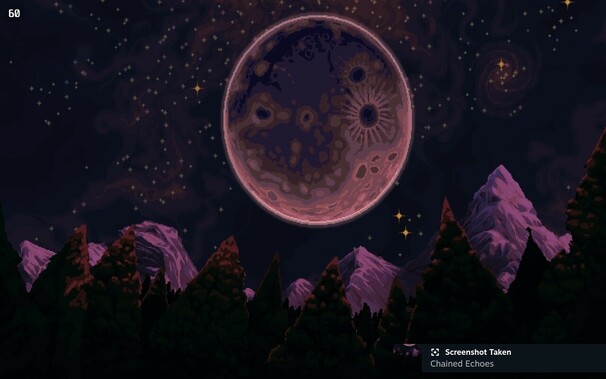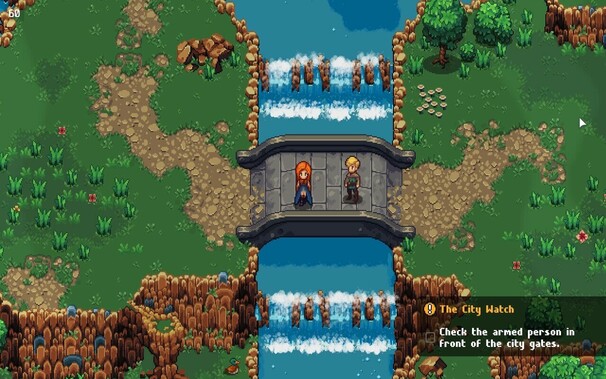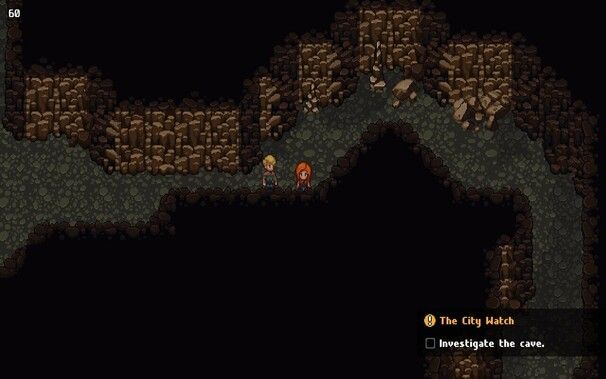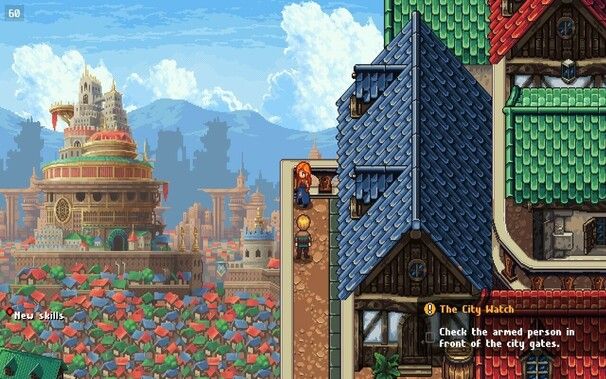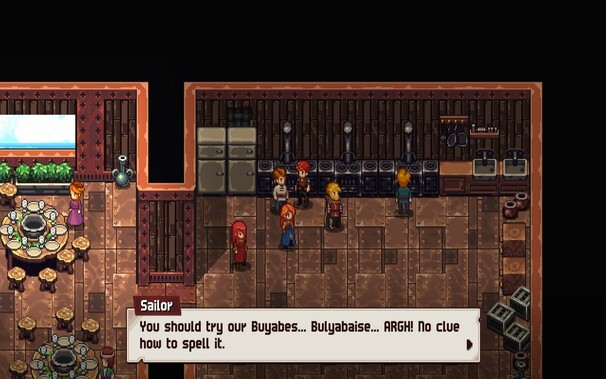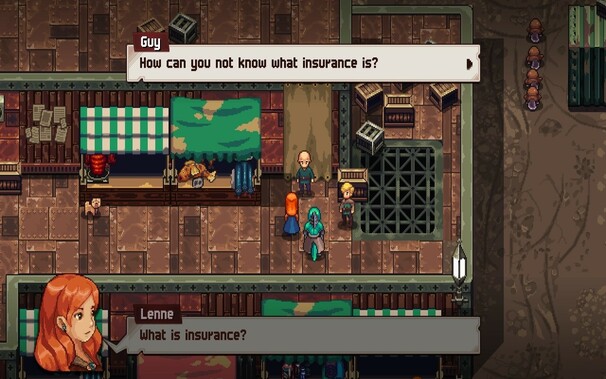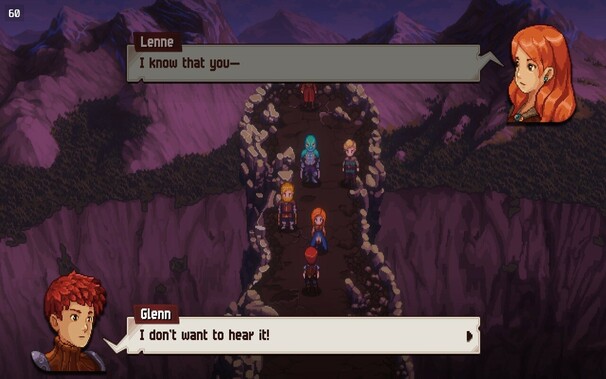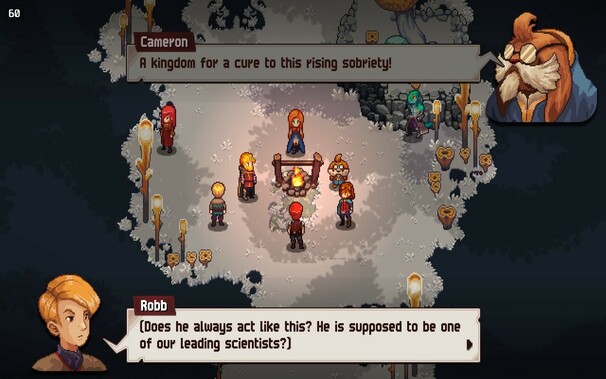Chained Echoes (PC, Steam Deck) Review
Chained Echoes is a phenomenal, classically-styled indie RPG that proudly showcases the nearly seven years of love poured into it. Few rough edges betray its almost single-developer origin. It’s beautifully well-written, expertly paced and – while it does not always pan out – dares to do things differently to the loved classics that inspired it.
I need some pictures from Chained Echoes for my review but getting screenshots off my Steam Deck and into here is an enormous hassle so here are three… have fun!
Most of the building blocks of Chained Echoes aren’t groundbreaking or new, but it pieces things together into a cohesive whole that feels modern and streamlined without leaving its 2D JRPG roots behind.
Most noticeable in the early game is the reduction of busywork. You won’t be bored to tears by the minutiae of your characters stats and you don’t need to micromanage your inventory. In true modern videogame style – exploration and completionism are benchmarked by in-game achievements so you’ve always got a means to benchmark your explosion. Achievements are rewarded handsomely, too, giving you essential in-game items and upgrade materials to make the most out of your characters.
Indeed the achievements in some way take the place of the grind for character levels. The game feels more or less balanced around you exploring and chasing those rewards, and – for me at least – remained consistently challenging if not sometimes quite tricky throughout the game. Even the simplest of “trash mob” encounters can be quite challenging, and I’d often find myself completely overrun by an enemy and forced to reconsider my strategy.
But losing a battle isn’t a problem. You can flee from most fights, and even if your enemies get the better of you you can just retry with no penalty until you get good or get lucky.
HP (health) and TP (mana) are reset after each fight, too, even in some cases where fights progress to a second phase, and this in effect makes every battle a self-contained puzzle, challenging you to master the game’s overdrive system and heavy focus on elemental weaknesses and debuffs. In fact debuffs are powerful in Chained Echos, you’ll rarely come across an enemy that outright resists status effects and stacking as many buffs (on your own characters) and debuffs (on the enemies) as you possibly can is crucial to success. The canonical example- since it’s the combo you’ll get access to early on in the game – is Oil as a debuff to increase fire resistance. Cast “Oil Slash” with your melee character and your Valkyrie-themed mage can hit hard with “Fire Strike.” This stacks with enemies’ intrinsic weaknesses, too, so you can really dole out the damage by setting up your attacks a little more carefully. Unlike the traditional RPG elemental systems focusing on opposing elements, every elemental weakness has an explicit status effect that enhances the damage done. In addition to “Oil” enhancing fire damage, “Dry” will enhance water, “Wet” will enhance wind and “Heavy” will enhance earth.
The “Overdrive” system, which later is reflected in Mech battles (known in the game as Sky Armour) in a slightly refined way, is an attempt to stop you finding the one most powerful combo and just going unga bunga on your enemies. It’s a bar with three sections: the wind up, the overdrive and overheat. As you use abilities you’ll move your cursor toward the overdrive section, which grands you increased damage output and damage resistance. Overshoot the overdrive and you’ll overheat, though, where incoming damage is enhanced and your damage output is reduced. You must use either the indicated skill type, or certain other actions to try and nudge your cursor back to the overdrive region. Often unga bunga still works, and you can smash your way right into overheat and win a battle with half your party wiped out.
I don’t want to spoil too much, but there are encounters that mess with your overdrive bar too. It’s a fun little spin on the mechanic when it happens.
When you use Sky Armour later in the game, the battle system changes up with a slightly different spin on the overdrive bar. It doesn’t feel quite as considered, though, and I’m not sure I like Sky Armour battles at all. I haven’t finished the game yet, though, so we’ll see! You can customize your Sky Armour colours from a list of pre-made palettes, including some very thinly veiled Neon Genesis Evangelion choices.
In all combat Chained Echoes eschews the genre trope of barely making it alive from one checkpoint to the next, perhaps accommodating the change in life circumstances that those of us who grew up with 16bit RPGs might have experienced. Gone are silly things like running in circles to regenerate mana, or opening up the character menu to cast health regen spells between one battle and the next. Some would say that Chained Echoes is streamlined to a fault, stripping the challenge of conserving resources across multiple battles. I respect that opinion- but I’m finding it’s forgiving nature an absolute godsend when squeezing it between bouts of work and parenting.
Gear and weapon upgrades are largely refined, too, in most cases a newly found weapon will represent – once fully upgraded – an improvement over an existing one. There are no weapon-specific special abilities or enchantments, you must enhance each weapon individually to your own taste using the Crystal system. Unfortunately the Crystal system feels like it’s punishing you for trying to understand its complexity. While most things in Chained Echoes feel forgiving, streamlined and outright friendly to use, the Crystal system starts out as a confusing mess and quickly devolves into a more confusing one. I won’t bore you with the specific details because I’m sure I’ll get something wrong. In short, it’s unnecessarily over-complicated and does not sufficiently reward you for dealing with that complexity.
The punishing crystal system, and rather uninteresting nature of individual weapons and armours has the effect of making gear swaps more or less redundant. There are some cases where you might make the choice between light or heavy armour for a character, leaning into their skills or crystals to get bonus defense, but you’ll never need to swap out gear to adapt to a fight.
While you won’t be tracking down legendary weapons to grant your characters unique skills, Chained Echoes does replace this concept with “Class Emblems.” A Class Emblem can be earned by possessing a special item, finding a statue and winning a – usually reasonably difficult – battle encounter. Once obtained, each character can have a single Class Emblem which is managed in the same way as gear. This then grants them bonus class skills and stat bonuses in the way I wish weapons did.
While a vast majority of the graphics and level design are absolutely brilliant there are definitely some warts. A lot of places that look walkable aren’t, there are a lot of visual issues with “lighting” (insofar as you can say a 2D, tile-based game has lighting) which you might just chalk up as aesthetic choice.
Okay I do need to illustrate a point here, what’s going on with the lighting?
Sometimes the graphics – while still quite beautiful – aren’t quite as cohesive as you might expect- two beautifully drawn scenes with clashing perspectives trying to illustrate a much larger space. Granted it will take a deliberately critical eye to notice these cases and you’re already taking some visual liberties with 2D, tile-based art anyway. It’s an indie game, and for a mostly one person effort it looks truly fabulous. I think I make these critiques more to prove I’ve actually bothered to look at Chained Echoes with a critical eye, and not just enjoyed playing it for 26 hours uhh…
And another with two beautiful but clashing perspectives intended to (and succeeding at) making the world feel a little bigger.
The writing and story pacing of Chained Echoes brings it together well. It’s quite “adult” in its content- exploring some dark topics, including alcoholism and beyond. It feels very much like 90s point and click adventure humour grafted into a 2D RPG. It works. It does some fun things with subverting genre tropes, drops you right into the action and interleaves the goals and journeys of multiple characters into one overarching narrative. It does an extraordinary amount of world building in a very short amount of time but – and I will have to credit James Stephanie Sterling for this salient point (I usually avoid any critical commentary about a game before I’ve written my own review, but this slipped into Podquisition): many, many, many concepts and ideas have been packed into this game both in terms of the plot, world building and mechanics. Chained Echoes needed someone to say “no, let’s cut that out.”
More screenshots from Chained Echoes - a touch of humour perhaps?
I am, at time of finishing this review, 26 (32 according to Steam?) hours into the game and I think my slow, methodical pace might lead me through another 10 hours. It’s not a long game by RPG standards but it is a satisfying, nostalgic take on the classic JRPG genre. Chained Echoes exudes all the love and attention that’s been poured into it. It also runs beautifully well on the Steam Deck, sipping battery and being all too easy to lose many, many hours playing. It has a few little hiccups when playing after waking from sleep, causing battle animations to lag for – before a recent patch – quite a long time. I mean, “force quit the game because it looked frozen” long. That seems to have settled recently, albeit not totally gone, recently.

